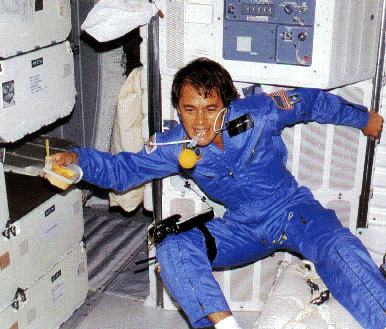-
WHAT IS NASA PHYSICS?
-
MODULES
-
Forces and Motion
-
Conservation of Momentum & Energy
-
Temperature and Heat
-
Fluids
-
Optics
-
Electromagnetic Spectrum
-
Modern Physics
-
Anticipation Guide 7
-
Intro to Modern Physics
-
Blackbody Radiation
-
The Ultraviolet Catastrophe
-
The Photoelectric Effect
-
Bohr's Atom
-
Spectra
-
Radioactive Decay
-
Special Relativity (SR)
-
Simultaneity
-
Distance and Time
-
General Relativity
-
May the Forces be with You
-
Modern Physics Notebook
-
Assessment Problems 7
-
-
Useful Things
-
-
SITE MAP
Fluids: Liquids and Gases
Pressure in Liquids
Water in the Microgravity of Space
Ball of orange juice unleashed in microgravity. Image credit: NASA. NASA calls weightlessness in space, microgravity. This implies that the acceleration of gravity is much less than on the surface of Earth. But at an orbit of a few hundred kilometers above the surface – where the International Space Station orbits – g is still about 9.0 m/s2, compared to 9.8 m/s2.
NASA calls weightlessness in space, microgravity. This implies that the acceleration of gravity is much less than on the surface of Earth. But at an orbit of a few hundred kilometers above the surface – where the International Space Station orbits – g is still about 9.0 m/s2, compared to 9.8 m/s2.
Weightlessness occurs because the spacecraft is constantly falling. But the Earth is also constantly curving away from it, so craft has just the speed to always be in freefall – the fall is balanced by the pull of gravity so astronauts float. That, and looking out the windows at Earth, are the two things astronauts like most about being in space.
With weightlessness in space there appears ….
If you pop a balloon full of water in space, what happens? The balloon peels away from the water, but the water hangs around as a floating ball of liquid. While the ball can be broken up, there will be much bigger “drops” of water than would form on Earth, where gravity pulls down the droplets once they achieve a certain size and density greater than that of the surrounding atmosphere.
So the surface tension of water accounts for bubble and water drop formations, capillary action, and floating balls of water – and floating orange juice balls in microgravity.
Microgravity
In microgravity, there is no “down” and liquids float. This doesn’t occur on Earth or any other planet, but astronauts orbiting the Earth have played with water inside the International Space Station, with amazing and amusing results.
© 2013 by Wheeling Jesuit University/Center for Educational Technologies®. 316 Washington Ave., Wheeling, WV 26003-6243. All rights reserved. Privacy Policy and Terms of Use.

